. . . .
SATURDAY
December 21 2019 - Farlington Marshes
On Dec 22nd
the Friends of Wildlife group visited Farlington
Marshes. Report by Ros Norton
A select group of six met two hours after high tide
for an anticlockwise circular around the marshes. Half
way through the walk we were joined by another
carrying a useful telescope.
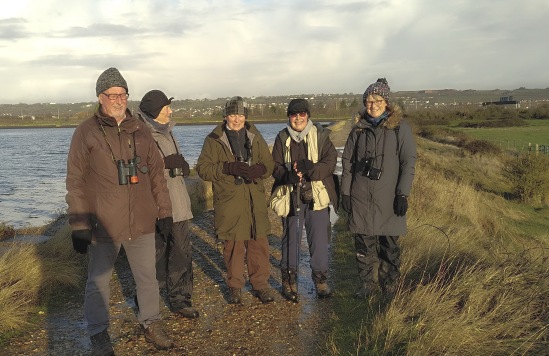
Greenfinches were in
bushes near the entrance. On the lake were pintails,
wigeon, teal and shelducks. In the harbour were brent
geese, a merganser and a distant line of avocets, 39
counted later. on the Portsmouth side. There were
brief sightings of a marsh harrier from the lake area
but we saw 2 together later as we looked back to the
west from the east side.

As we walked around we
saw a group of dunlin, a turnstone, lapwings,
redshank, oystercatchers, skylarks, pipits and an
egret. A distant seal was seen from the Point in the
harbour and some rabbits were in the marshes.
At the Deeps we saw many shovellers, shelduck, teal
and brent geese. A Cettis warbler was heard and
probably seen as 2 birds flew in the reeds. A large
white goose was with a group of Canada geese in a
field and there was a group of about 40 curlew. We saw
coots in the stream by the hut. We decided not to
return via the marshes as it was very wet underfoot.
We experienced rain as forecast later on in the walk
but the sun still came out which produced some lovely
rainbows.
Flowers included bristly ox-tongue, yarrow, ragwort,
white deadnettle and smooth sowthistle.
Ralph's
new home
On Dec 23rd
Ralph Hollins sent me this view of his new home from
across Carlingwark Loch in Castle Douglas in
Scotland.

When he walked
round this loch this morning he saw 8 Goldeneyes!!
SATURDAY
December 14 2019 - Nutbourne - Prinsted
Report by
Neill Foster
At Farm Lane, a group of eight dressed up warmly on a
dry but cold and windy morning.
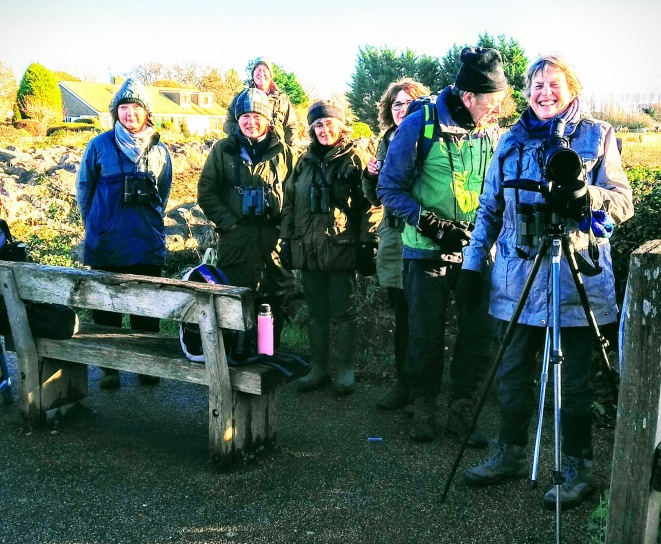
A great spotted
woodpecker flew over and we set off along the path
down to the shore. The hedges were populated by the
usual resident house sparrows and robins.

On the marsh, along
the way, we also found teal, mallard, a male pheasant,
and we heard a distant green woodpecker. On the shore,
feeding on the rising tide, were numerous Brent geese,
along with widgeon, grey plover, pintail, dunlin and
several curlews.
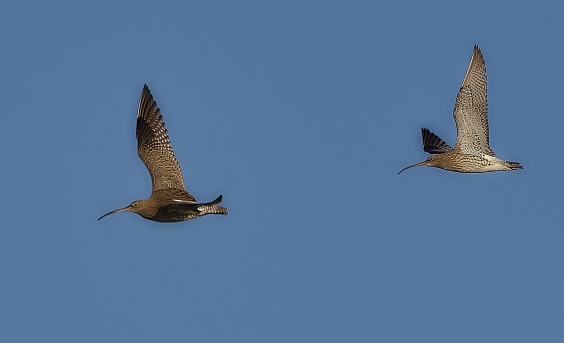
Over the fields behind
us five meadow pipits bobbed around and a sparrowhawk
flew over.

On the sea we found
only a distant great crested grebe and three flying
cormorants. The walk along the sea wall was against a
strong headwind and there was little to be seen other
than a kestrel over the fields, a buzzard further
inland, spotted by Heather, and a sizeable flock of
lapwing that Caroline alerted us to in the distance
over Thorney. Around the point were more brents and
curlews, plus some common redshank. Prinsted harbour,
which gave us some shelter for our coffee break, held
plenty more brents, oystercatchers, and a few
turnstones busy in the seaweed. A couple of blue tits
popped up to enjoy a brief spell of sunshine. Heather
found a lone red-breasted merganser on the sea.
Heading back we saw four more meadow pipits, a single
pied wagtail and five more curlews feeding in the
field behind the sea wall.

We turned inland along
the footpath past the old orchards where we were
pleased to find, after some searching, both redwing
and fieldfare.
The only flower seen
on the walk was a late white deadnettle.
SATURDAY
December 7 2019 - Titchfield Haven
A festive
fourteen met at Titchfield Haven for this week's walk.
We were captivated by the turnstones in Hillhead
harbour which were very close but completely oblivious
to us. While waiting for the visitor centre to open an
eagle eyed Heather spotted a group of common scoters
quite a way offshore. A much larger group of around 24
eider ducks were also spotted and we had wonderful
views through the scopes. Even though it's not yet
winter there were some pairing displays with head
bobbing. The great crested grebe just offshore was
almost ignored in the excitement. Gadwall, coots and a
little grebe were on the lake viewed from the road.

There was a lot to see
from the first hide in the reserve. One of the islands
in the lake was almost filled with oystercatchers and
on another a solitary avocet was in the company of
some lapwing. A kingfisher perched close to the hide.

On the water were
numerous teal, shelducks and shovelers. Redshank and a
few black tailed godwits were feeding in the shallows.
Three well disguised common snipe were feeding at the
water's edge and a pale buzzard was roosting in a tree
in the distance. From the second hide we saw more
oystercatchers, teal, redshank and a group of lapwing
flying back and forth in formation. Small birds seen
included pied wagtail, goldfinches, robins and a pair
of blackcaps near the visitor centre.

As we walked back
along the shore the tide was going out and feeding
along the waters edge were Brent geese, dunlin,
sanderling and a ringed plover.
It was good to see the
small birds in fairly close proximity to compare their
features. We finished with a hearty lunch in Breezes
cafe and a jolly time was had by all.

SATURDAY
NOVEMBER 30 - 2019 - Pulborough Brooks
Far Durant
reported on this morning's walk. Saturday morning
found eight of us at Pulborough Brooks , well in time
for the 9-30 am opening .
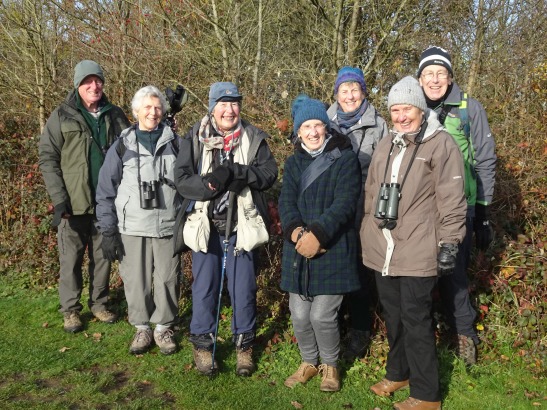
It was a crisp , cold
morning with no wind ! Driving down we passed fields
covered in white frost and pools of water , frozen
over , very attractive . The sun showed its face
periodically and not a drop of rain .As we walked out
of the centre we encountered a group of very friendly
sparrows , flitting around the bushes and a robin who
was endeavouring to catch our attention . Neill turned
round , bought some mealworms , which were gratefully
received
.The blackberry bushes
still bore fruit , covered in frost , looking like
raspberries in the sunlight . We noticed a piece of
wood covered with fungi which could have been many -
zoned polypore . In the trees were various tits : blue
, great , coal and long tailed , plus greenfinch -
male and female , blackbirds and a single redwing ,
later spotting a couple more . No fieldfare were seen
.
We visited four hides , looking particularly for the
marsh harrier . Neill spotted one flying , being
mobbed by crows . On the lakes were numerous shovelers
, pintails , teal , wigeon , lapwing and great numbers
of black tailed godwits - over 450 -on one count . We
were thrilled to see not one but three peregrine
sitting on posts , several buzzards , one producing
much discussion as it appeared so white in the front
with dark markings . A cormorant was sat on an island
and the usual moorhens , coots , swans and an enormous
gathering of Canada geese .
There were probably more species to be identified but
the birds were a long way off and could only be
identified with a scope . We were shown a kingfisher ,
at a great distance , on a sluice gate . Again , a
friendly birder , pointed out several snipe , well
camouflaged amongst the rushes .
We happily returned to the cafe for a hot drink and
some food . I think we all felt it had been a very
enjoyable morning. Thank you so much for the use of
the scopes , which made it very worthwhile .
Discussion on starlings : flocks are flying in from
Eastern Europe for our milder weather .
SATURDAY
NOVEMBER 23 - 2019 - West Marden
Steph Dale
reports on this morning's walk . . .
The weather forecast was not good but 9 of us bravely
turned up in West Marden ready for a Saturday morning
walk. We were rewarded as, apart from a little light
drizzle near the beginning, the weather stayed dry. It
was grey but there was no wind at all. Our route was
up the main street a little, north to Bottom Copse and
then to Compton where we stopped for our coffee in the
churchyard. We then walked past the primary school and
south along the bridleway back to West Marden.

We spent some time on
the main street of West Marden as we watched and
listened to birds in gardens, including great tits,
blue tits, nuthatches, goldfinches, robins, Coal Tit,
sparrows, jackdaws, a song thrush and possibly a flock
of redwings.
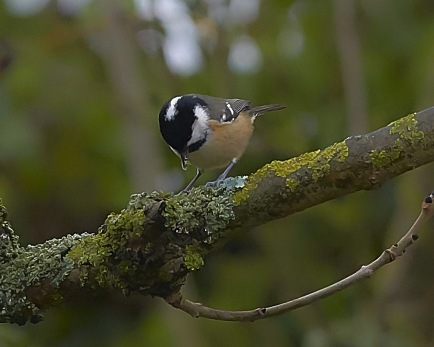
Along the next part of
the walk we spotted several collared earthstars and
also a white saddle fungus (helvella crispa).
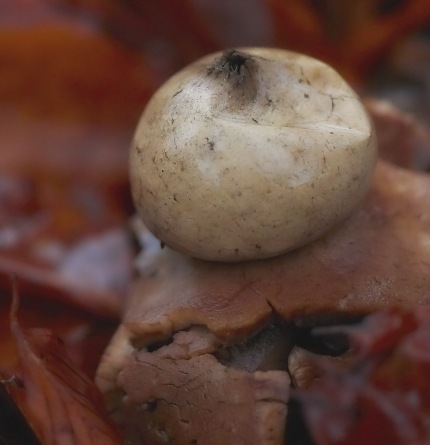
We all stopped to
enjoy the beautiful clear song of a mistle thrush.
Before we reached Compton we saw chaffinches, long
tailed tits, coal tits, a marsh tit, herring gulls,
enormous flocks of wood pigeons also goldcrests and
firecrests, magpies, dunnock and wrens.
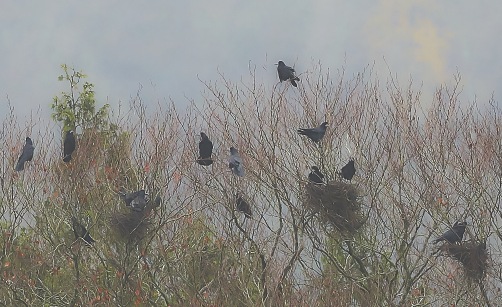
Walking through a
fenced off pheasant rearing area, we noted a lot of
snowberries, presumably seeded there from a garden.
Walking through Compton, we heard (but did not see) a
song thrush very close by behind a garden hedge.
Between Compton and West Marden we had a very good
view of a red kite flying over low and later a buzzard
perched on a telegraph pole.
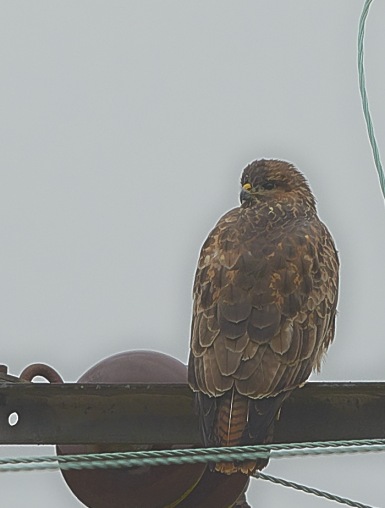
We enjoyed watching
chaffinches, greenfinches, yellowhammers and a large
flock of fieldfares. Across a bare field we saw a good
number of red-legged partridges. Throughout the walk
we saw and heard plenty of pheasants.
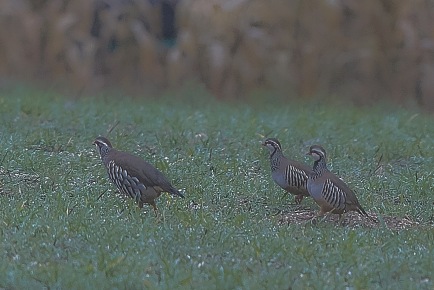
We saw very few
flowers but did see small amounts of yarrow, white
dead nettle and periwinkle in flower. We returned to
our cars dry but somewhat muddy! Thanks for your
company, one and all.
SATURDAY
NOVEMBER 16 - 2019 - Hayling Oysterbeds
Nicola Hammond
reports on this morning's walk
A jolly group of 13 met at Hayling Oyster beds on a
chilly morning, but with the promise of sunshine.
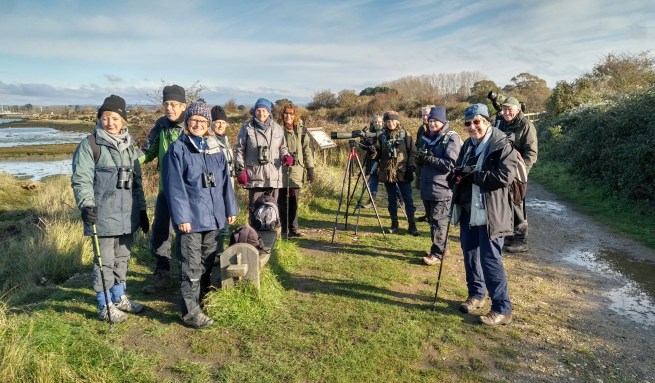
From the bank at the
car park we surveyed the mudflats and spotted numerous
redshank, curlew and Brent geese. As we walked along
the path a rock pipit darted in front.
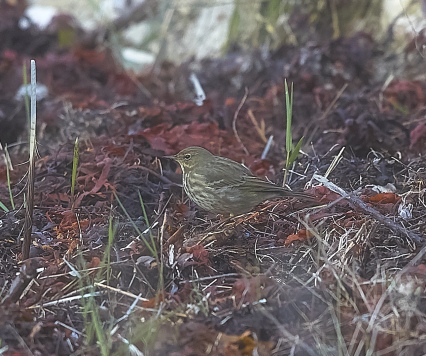
Further along we saw a
grey plover, turnstones, oystercatchers, shelduck, a
great black backed gull and yet more curlew, One of us
saw a gull with what seemed to be a crab in its beak
and another clearly saw a crow tucking into a crab it
had caught.
On the first of the pools two little grebes were
swimming in the distance and a colour ringed
greenshank stood out on the water's edge. We were
treated to wonderful views of a kingfisher as it
perched on the rocks and then hovered above the water,
hoping to catch a fish.
There were a lot of birds swimming out on the open
water and in particular red breasted mergansers and
great crested grebes. We had good views of two
goldeneye and also four black necked grebes which are
quite a rarity for the area. A sandwich tern dived in
front.

A large group of
dunlin flew low over the water as the tide came
in.
A cetti's warbler was heard and song thrush,
greenfinches and a kestrel seen. We welcomed the
warming rays from the sun later in the morning.
Finally little egrets were all around the shoreline
but, as we said, tend not to be commented on as they
are so commonplace now - like blackbirds!
It was a good morning's birdwatching, in great company
as always.
SATURDAY
November 9 - 2019 - Hollybank Woods
Valerie
Mitchell reports on the Friends of Wildlife walk
Six of us met at Hollybank Woods and we noted the
large number of houses built near the entrance, the
nearest house had pulley systems in their back and
front gardens to keep the numerous bird feeders up
high off the ground, nest boxes were also located in
nearby trees, blue and coal tits were seen feeding,
goldfinch, greenfinch and woodpecker were also spotted
before we entered the Woods. Many of the yellow
pyracanthus berries had been eaten by the birds.
On entering the Woods we admired the dead hedging and
immediately turned right at the first section, it
wasn't long before we came across a long, fallen
chestnut trunk that supported about 5 different fungi,
unfortunately we didn't have a fungi expert with us
this time, but it did not stop us from photographing
and admiring them.

Firecrest and
goldcrest were spotted flitting about in the trees,
wren, nuthatch, jay and longtail tits were also seen.
There was evidence on several old tree stumps of
squirrels enjoying the abundance of sweet
chestnuts.
On reaching Emsworth Common Road, it was decided not
to cross the road to Southleigh Forest as planned
because rain was forecast to start at 11am, so we
proceeded in a westerly direction, then diagonally
back towards the main entrance. We passed a large area
where there were many piles of holly tree prunings and
prepared stakes, working teams had obviously been very
busy during the week.
The ground was littered with autumn leaves, but we
were still able to spot many fungi, these included
earth ball, common puffball, candle snuff (stag's
horn), various bracket, turkey tail, amethyst
deceiver, fairy bonnet, several black fungi, milk
caps, sulphur tuft, fly agaric, jelly fungus, coral
spot and parasols. Many appeared in large groups and
were very large in size.
We arrived back at the entrance just as the predicted
rain started.
Thank you all for coming, next time we will remember
"the little mirror on a stick", thank you Steph for
bringing your fungi book.
SATURDAY
OCTOBER 26 - 2019 - Chidham
Neill Foster
reported on Saturday's walk by the Friends of Wildlife
group
A group of eight met at Thornham Lane on an overcast
and windy morning. After an assessment of the
conditions, particularly the exceptionally high tide
and strong south-westerly wind, it was agreed it would
be better to relocate to the Chidham peninsular.
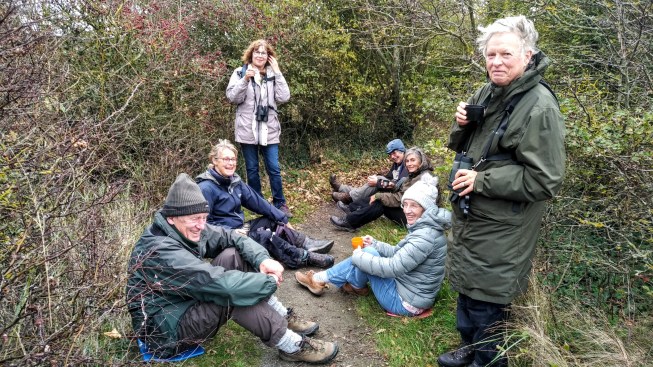
From the car park
there, along the field boundary to the shoreline, we
straightaway could see more of interest. Flying above
the field were a flock of thirty meadow pipits, a
couple of skylarks and a cormorant. In flower along
the footpath were black nightshade, wild carrot, hedge
mustard, shepherd's purse, groundsel, scentless
mayweed, an unconfirmed speedwell species, smooth
sowthistle and red deadnettle.
At the shore, pintail and brent geese were flying; a
little grebe and about thirty brents were on the
water.

A wren was heard in
the bushes but not seen. Along the coastal path the
red and orange of glasswort and other species made a
colourful display along the landside channel and there
was bristly oxtongue, gorse, white deadnettle.
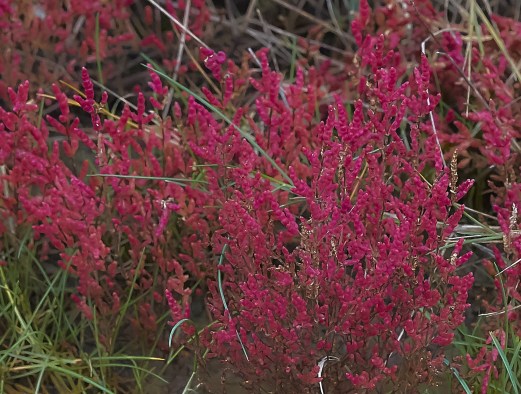
Some had a brief view
of a small mammal swimming ashore from the sea and
Derek was quick enough to capture a picture before it
vanished into the marginal plants. Opinion was divided
between either a small brown rat or a water vole.
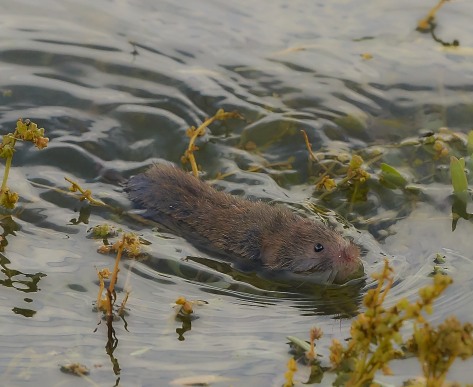
Further along we found
some teals, mallards, a blue tit, moorhens,
greenshanks (group of six), black-tailed godwit,
redshanks, little egrets, stonechats (a few
individuals, including one carrying food), jackdaws (a
large flock over), a couple of chaffinches, a green
woodpecker, oystercatchers (roosting in a long row),
curlews, and rock pipits. Amongst another group of
brent geese on the tidal lake was one unusual
individual with a white head and black face: partial
leucism or possibly a hybrid?
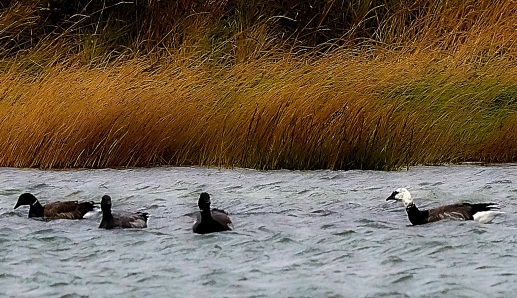
Peter
Milinets-Raby comments that the Goose is a Brent
Goose. Note size in relation to other Brent in photo.
Also it has Brent Goose flank markings and even has a
Brent Goose bill. He thinks it is a Brent Goose with
partial albinism. Interesting individual. It is not
clear from the photos but not a cross with something
else.
Ivy was a mass of
flowers (and insects) and one teasel was also in
flower. Others were green alkanet, scarlet pimpernel,
creeping cinquefoil and common mallow.
At Cobnor Point we had to take shelter behind the
hedge for our coffee break as the wind had increased
to at least gale force nine. Heather spotted a
(probable) sandwich tern and a turnstone flying but
they were soon gone!
On the return path, stonechats, rock pipits and meadow
pipits were still around, and we added buzzard and
grey heron. A flock of about twenty waders, light
brown and with clear pale under parts, banked and
circled a few times before landing in the field beyond
the road. We scanned through a gap in the hedge,
eventually finding and confirming golden plovers
together with a single lapwing.
Thanks to all for braving the windy conditions and for
the help especially in identifying the wild flowers.
Thanks to Derek for the super photos.
SATURDAY
OCTOBER 19 - 2019 - Petworth Park
Steph Dale
reported this morning's walk
Four of us met in the northern car park at Petworth
Park. We were in good cheer as, after the recent very
wet weather, we were lucky to be walking on a
beautiful sunny blue-sky day. Our route was south to
the large lake in front of Petworth Park and then back
to the car park by a more westerly route.

Immediately we saw
fungus and we continued to see plenty during the walk.
We identified the parasol mushrooms but we were not
able to identify others.
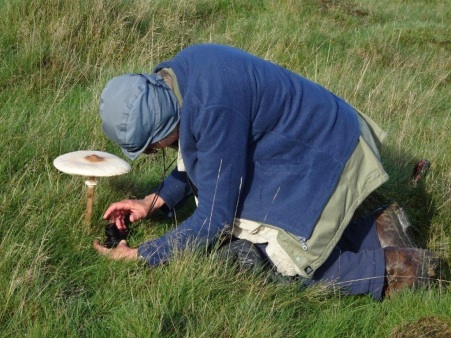
Having looked at my
photos, I have had a stab at identification by
consulting my fungus book. I think we saw milky bell
cap, yellow cracked bolete and common yellow russula
but I stand to be corrected by anyone who is more
expert!
yellow cracked
bolete
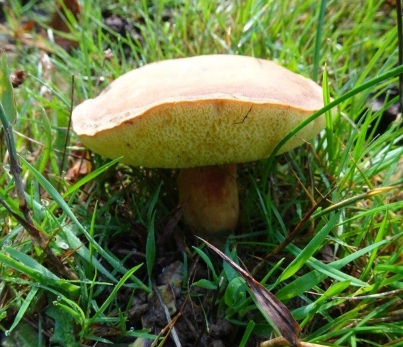
There were fallow deer
wherever you looked, many in a state of agitation or
movement but some very relaxed lying in the sunshine.
The stags were 'barking' and pacing about and some of
the hinds were 'mewing'. The rut was under way and it
was fascinating watching all the movement and trying
to work out the reasons for some of the behaviour.
Sometimes a herd seemed to have several stags attached
but no signs of aggression were evident. We saw no
mating of deer nor any fighting during our walk. The
colour variation of the deer was very marked with some
very pale deer, some with beautiful pronounced pale
spots on a reddish coat and some dark-coloured deer
with no spots.

We noticed that there
were jackdaws very close to some of the deer and even
alighting on them. We discussed whether the jackdaws
might be looking for ticks in the coats of the deer. I
later looked online and found that other people had
observed the same thing with fallow and red deer; the
conclusion was that the jackdaws were indeed looking
for ticks and fleas or, if they were seen doing this
earlier in the year, they were plucking loose hair
from the deer for use in making nests.
At the pond we saw
some Egyptian geese in flight and then several
alighted on a dead branch of a tree where we were able
to get a good view of them.
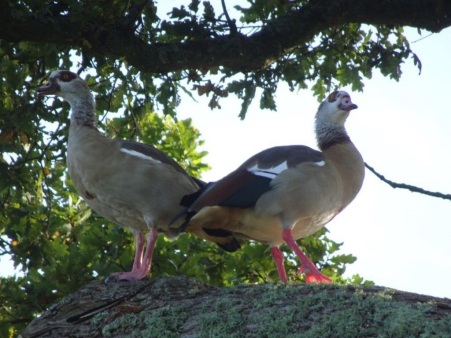
We saw several red
admirals and towards the end of the walk we saw a
small heath resting on the ground.
At the lake we sat on the seats above the boat house
to have our coffee and to see what birds were about.
We noted pochard, Canada geese, tufted ducks, little
grebe, mallards, coots and moorhen. Also about 14
house martins flew over. Elsewhere we saw a robin,
blue tit and goldfinches. We got a very good view of a
red kite flying low over us in the sunshine and we
later saw a kestrel and a heron.
Thank you for your company, fellow walkers.
SATURDAY
OCTOBER 12 - 2019 Havant Thicket
Heather Mills
reports on this morning's walk by the Friends of
Wildlife group
On a somewhat soggy morning 4 attended Havant Thicket
to see what fungi we could find as well as a few
welcome birds. From the car park there were a few Coal
Tits with Great and Blue and Long-tailed foraging high
in the Silver Birches. Occasional Jays passed
overhead. Although we missed most of the rain, the
terrain was very wet and the fungi species attacked by
slugs as one of Derek's picture shows. I have tried to
identify a few but not with certainty. The most
prolific were Fly Agaric and Pestle as well common
Puffballs. It was good to find a trail of Helvella in
a few spots along the tracks.
Fly Algaric . . .
Common Puffballs . . . Helvella . . . Parasol
Sulphur Tufts

Flowers were few but
we did find bramble, red clover, Ragwort and a
Devil'sbit scabious hanging on.
SATURDAY
October 5 - Langstone
Ros Norton
reports on the Friends of Wildlife walk
A group of 7 met at Langstone on a pleasant sunny and
calm morning for a walk by the Mill Pond and across
field to the Billy Line back to Langstone. We crossed
the main road and walked along Mill Lane to South
Moors at low tide.
A grey wagtail was seen near Langstone Mill House. At
the Mill Pond we saw a swan with 5 large cygnets, many
mallards, coots, moorhens a teal, a tufted duck, some
little egrets and a heron. Goldfinches were feeding on
the alder.
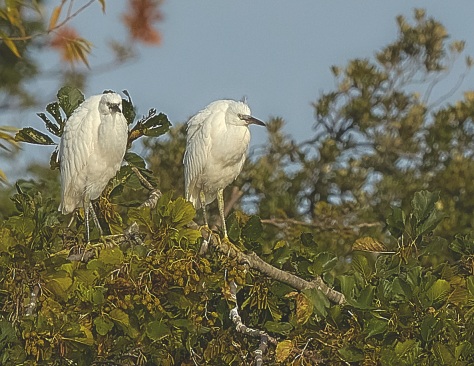
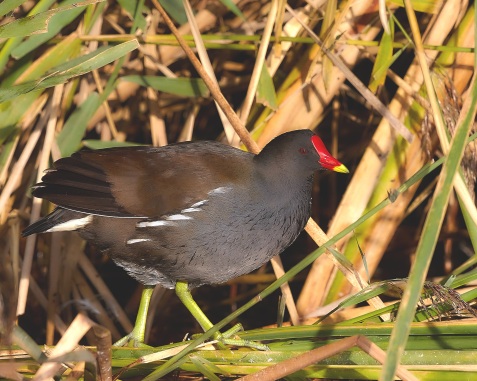
Michaelmas Daisy
flowers were attracting bees and there were a few late
flowers on golden samphire. A squirrel bounded across
a nearby field, a jay flew over and pheasants,
woodpigeons , magpies and a crow were on the
ground.
We walked along the Billy Line where we saw bristly
ox-tongue, hedge bindweed. Hedge bedstraw, dandelion,
yarrow, herb Robert, white deadnettle, mint, yarrow
and hogweed. Crossing over the road to Mill lane we
had a surprise encounter with several young giant puff
balls. Ivy flowers attracted a red admiral and
hoverflies.

At South Moors some
were lucky in seeing a kingfisher. We had good views
through Caroline' s telescope of a male and a female
kestrel on wires. A sparrowhawk flew over and a
distant stonechat was seen., also skylark, robins,
starlings and hedge sparrows.
Our coffee break
was at the mouth of the Langbrook stream where many
brent geese had gathered.

Other birds seen here
included a wheatear, great crested grebe, dunlin, grey
plovers, oystercatchers, knot, sandwich tern, curlew,
redshank and black tailed godwits.
Other flowers seen included meadow buttercup, red
campion, ragwort, bramble, hawkbits and prickly
sow-thistle.
Other birds included linnet, great spotted woodpecker,
house sparrows, black headed and common gulls, blue,
great and long tailed tits.
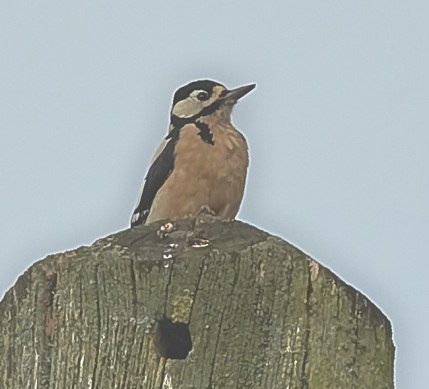
SATURDAY
SEPTEMBER 28 2019 - Farlington Marshes
Neill Foster
reported on yesterday's walk by the Friends of
Wildlife . . .
A group of nine met on a bright but very blustery
morning. There was a warm welcome for Jean, a new
member. Derek was taking the photo.

The tide was low and
rising. From the car park we could see greenshank,
redshank and ringed plover feeding. Because of the
strong wind it was decided to walk clockwise around
the marshes for an early check on the bushes.
But first we had a preliminary look at the Lake. On
the far side, beyond an impressive area of red
glasswort, were good numbers of wigeon, redshank,
greenshank and black-tailed godwit. In smaller numbers
were dunlin, coot, and mallard. There was a brief view
of a wheatear flying off and a brief call of bearded
tit from the reeds.
Along the reed bed path, sheltered from the wind, we
found greenfinch, robin, blue tit, at least two
spotted flycatchers, and some linnets flying over.

On the water were a
pintail, Canada geese, mute swans, and a shelduck.
Huddled together was also a substantial flock of
black-tailed godwits; they suddenly took flight but we
could not find any approaching raptor.
Near the information hut and beyond we found teal,
moorhens, stonechats and whinchats and then had a
brief view of a peregrine flying away from us. Also
present on the marsh were grey herons, little egrets
and, over the cattle, large aerobatic flocks of
starlings.
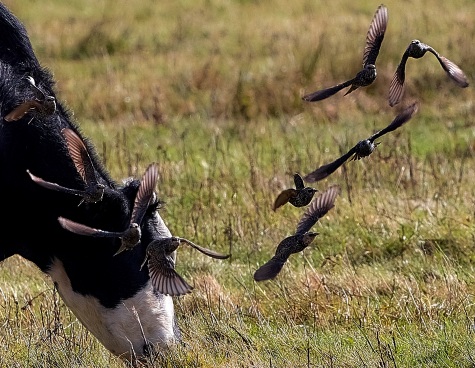
The peregrine returned
and flew over us across the sea wall. A sandwich tern
flew past and some reed buntings were moving around in
the bushes.
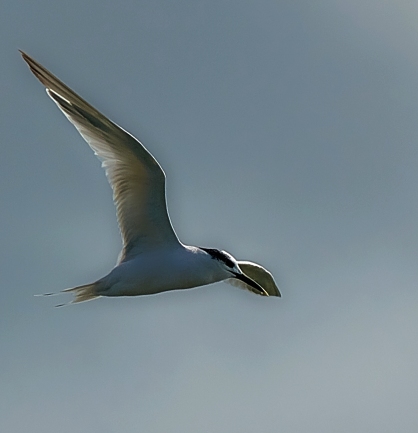
As we approached the
Point the tide was high and we could see a flock of
small waders looking for somewhere to settle. When
they landed, in a long row on top of the sea wall, we
could identify them: mostly ringed plover with just a
couple of dunlin.

On the landward side
were numerous meadow pipits feeding on the ground, a
couple of skylarks (not ascending much at all in the
wind!) and a single swallow.

A Large White here was
the only butterfly of the day. On our return along the
sea wall a curlew flew past but there was little else
to be seen as the wind had become even stronger. Back
at the Lake, even larger numbers of mixed waders and
ducks were huddled so tightly packed with heads under
wings it made identification of any further species
virtually impossible.
Wild plants of note (with thanks to Rosalind for
listing them for us) were fennel, fleabane, perennial
sow-thistle, bristly ox-tongue, ragwort, mayweed,
creeping thistle, red clover, yarrow, mouse-ear,
tufted vetch, rock samphire, glasswort, dandelion and
teasel.
Thanks to all who came along, making it a most
pleasant morning out. And, as always, thanks to Derek
for the photos.
SATURDAY
SEPTEMBER 14 - 2019 - Walderton
Steph Dale
reported on yesterday's walk by the Friends of
Wildlife group.
A happy relaxed
group of 6 met on a warm, bright and sunny morning at
Walderton.
We headed to Cooks
Lane and then northwards to Watergate Park. We crossed
the Walderton-West Marden road and walked south along
the bottom of Watergate Hanger. At the top of Brocks
Knapp we walked about half a mile along the top of the
hanger and then retraced our steps and headed back to
Walderton.
We saw swallows early on and later saw more swallows
(about 60) and some martins. Throughout a large part
of the walk we were aware of buzzards overhead as they
were calling loudly.
We came across a dead slow worm still partly hidden in
a hole in the ground and Neill spotted a damselfly
sunbathing on a fence post.
The ivy was in flower and on the flowers were many ivy
bees (first identified in the UK in 2001). Very
surprisingly we came across some cow parsley in
flower. We also identified groundsel, marjoram,
nettle-leaved bellflower, yarrow, cudweed, fleabane,
ragwort, hedge woundwort, scentless mayweed, dark
mullein, black nightshade, redshank, field bindweed,
common toadflax, spear thistle and creeping thistle.
We noted a few spurge laurel plants and the butchers
broom was bearing berries.

Butterflies included
small white, meadow brown and red admiral.
We listened to a hidden bird tapping in a tree for
quite some while. When it flew away we decided it was
almost certainly a nuthatch.
Although we enjoyed the walk, sunshine and company we
were a little disappointed that we didn't see more
birds.
SATURDAY
SEPTEMBER 14 - 2019 - Pagham Harbour
Heather Mills
reported on this morning's walk by the Friends of
Wildlife group
A select group of five met today at RSPB Pagham
harbour on a glorious sunny morning.
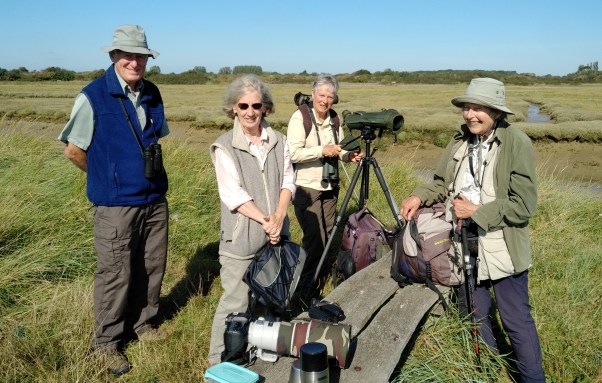
As I was early I
scouted ahead and had a Green Woodpecker with lots of
Goldfinch. A Spotted Flycatcher remained for the
others to see, when we ventured out to the new
hide.
A group of 29 Black-tailed Godwits lazed in the pool
near to the roadside. A lone Common Sandpiper dabbled
at the back whilst a plentiful supply of Swallows and
House martins hoovered up the wealth of insects as
they flew past. A flock of Teal dabbled in the pool
with some Black-headed gulls and Lapwing. Blue, Great
and Long-tailed tits flitted through the bushes with a
few probable Chiffchaffs, and Chaffinch, Greenfinch
and a good number of House Sparrows.. We ventured out
to the outfall area and along came a Kingfisher.
We retraced our steps back to the footpath and went on
our way towards Church Norton. A couple more Spotted
Flycatchers flew ahead so that we could identify them
and Derek got a picture of one with a fly.
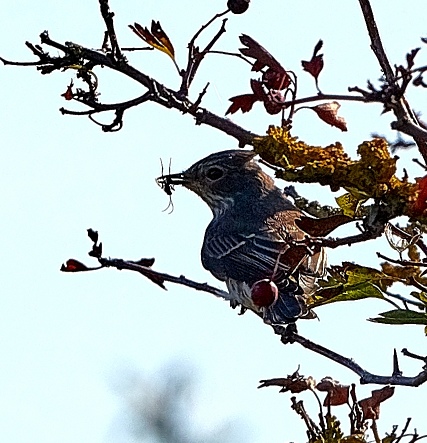
However, there were no
Reed Buntings at all heard or seen there and back.
Stock doves called and a few Pipits flew over. We
spent our coffee break overlooking one of the tidal
estuaries where a great many Curlew could be seen and
a few heard. Juvenile Shell Ducks and at least four
Avocets with Redshanks were seen in the distance. We
eventually proceeded along the footpath and Neill
spotted what turned out to be the bird of the day, a
Marsh Harrier. It was behaving rather strangely in
that it dabbled in the middle of the incoming tide.
Enjoying having a paddle it seemed!
Nearer to Church Norton we had good views in the
scopes of a couple of Ringed Plover with
Oystercatchers and a long line of Cormorants sitting
on a bank. Great Crested Grebes swam on the incoming
tide. Many Great Black-backed Gulls could be seen in
the distance. Other birds seen were a Buzzard and
Kestrel and we also had a Cetti's warbler practicing
it's song. A group of 4 Dunlin were seen as we
returned and had a final look at the ferry
pool.

Plenty of plants still
about. Jill could smell the Sea Lavender which was
abundant along with Common Mallow, White Dead nettle,
Pink and Sea Campion on the shore, White Campion on
the reserve. Dark Mullein, Black Knapweed, Hoary
Ragwort, Thrift, Black Horehound, Creeping thistle.
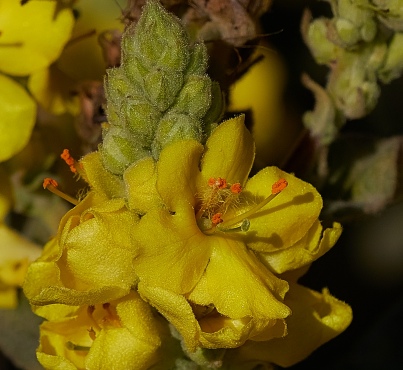
Butterflies seen, Red
Admirals, lots of Speckled Woods and plentiful Small
Whites. Small Copper, Silver y moth and a Painted
Lady. A very pleasant outing.

SATURDAY
September 7 - 2019 - Stansted Forest
The Friends of
Wildlife group had their Saturday morning walk in the
grounds of Stansted estate. Valerie Mitchell provided
the following report and Heather Mills the photos.
A
group of 9 met on a pleasant autumnal morning at
Stansted House Garden Centre car park.
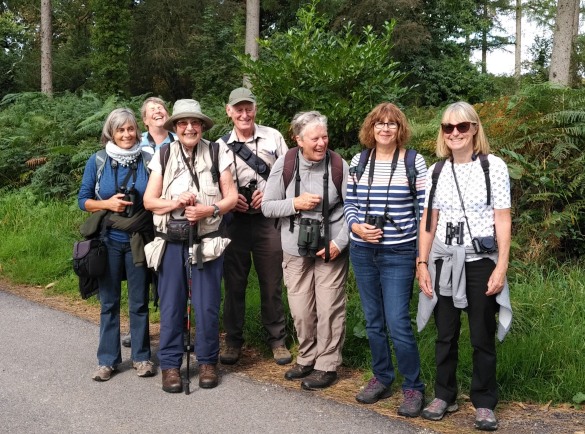
Walking
along the bridleway in front of Stansted House we saw
house martins and swallows flying around in front of
trees at the far side of the meadow, also stock dove,
jackdaws, chaffinch and pied wagtail. In the hedgerow
we saw 2 perfect spiders' webs complete with garden
spider on each.
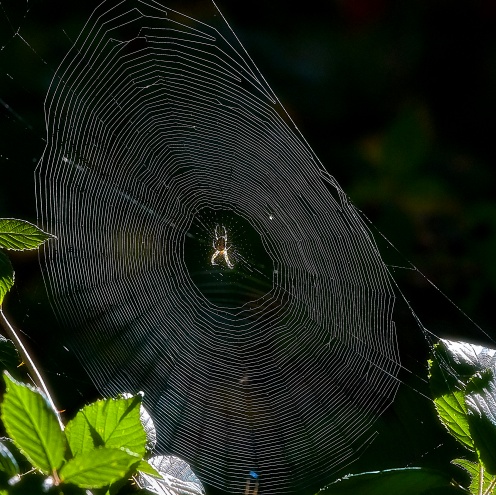
Green
and great spotted woodpeckers flew among the trees.
Later on we saw a young great spotted woodpecker being
fed. We continued up Rosamund's Hill and in a sunny
clearing we saw a beautiful female Goldcrest,
she moved around, but stayed in view for a long time,
her yellow crest shining in the sun (the male
Goldcrest has an orange crest). A spotted
flycatcher also flitted about.
On
turning around we spotted a brown hare, haring across
the field.
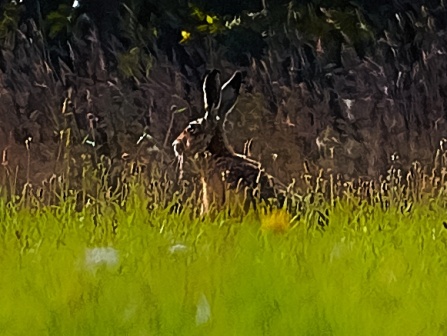
After
turning right onto the footpath we saw wren,
yellowhammer, flock of goldfinches, chiffchaff,
blackcap and heard a nuthatch. Buzzard was flying, and
one seen resting in a tree. A blue hawker was spotted.
Butterflies included large and small white, comma, red
admiral.
We saw
lots of wild flowers which were generally past their
best, but lovely to see. Also plenty of black, elder,
hawthorn and spindle berries, sweet chestnut, hazel
nuts, ivy flowers, rose hips and crab apples, plenty
of food for autumn and winter.
A
very bright patch of yellow Stagshorn Fungus was
spotted beside the road as we returned after an
enjoyable walk.
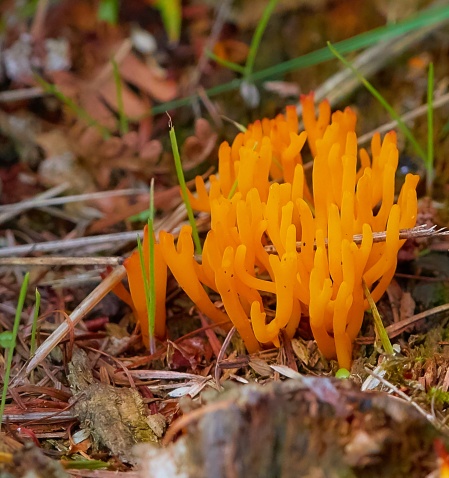
SATURDAY
AUGUST 31 - 2019 - Selborne
Steph Dale
reported this morning's walk: 8 of the group plus 2
grandsons did a lovely walk from Selborne village
along the National Trust Lythes to Priory Farm and
back along the opposite side of the valley.

Apparently Gilbert
White in his journal gives the origin of 'lythe' as
the Saxon for 'steep slope'. In his time the Short
Lythe was a pasture and the sunny bank was occupied by
field crickets. (Locals pronounce 'lythe' to rhyme
with smith.). Before leaving the churchyard, we paid
our respects to Gilbert White by visiting his grave
behind the church.
The weather was fairly cool and cloudy to start with
but later we saw sunshine. One of the highlights of
the walk was hearing, but sadly not seeing, a noisy
argument between some jays and a tawny owl in a wood
we were walking alongside. We later heard the owl
hooting when we passed along the opposite side of the
valley.
At the ponds we saw the pretty pink amphibious
bistort, yellow water lilies, water mint, water
forgetmenot, fleabane, meadowsweet and gipsywort. We
also saw coots and moorhens and a huge carp came to
the surface of the water.
Elsewhere on the walk
we noted great willowherb, black knapweed, meadow
vetchling, greater birdsfoot trefoil, musk mallow,
mouse ear, red campion, nipplewort, herb Robert, wood
avens, white stonecrop, enchanter's nightshade, purple
loosestrife, hogweed, angelica, hedge woundwort, hedge
bindweed, self heal, agrimony and greater plantain.
greater birdsfoot
trefoil

We watched a very
scruffy kite circle overhead and we saw 8 goldfinches
on a telegraph wire, blue tits, great tits, a buzzard,
wrens, robins and squirrels. We heard bullfinches and
nuthatches.
While we were sitting on a sunny bank having our
coffee break, we were pleased to see a silver washed
fritillary. Other butterflies seen were meadow brown
and small whites.
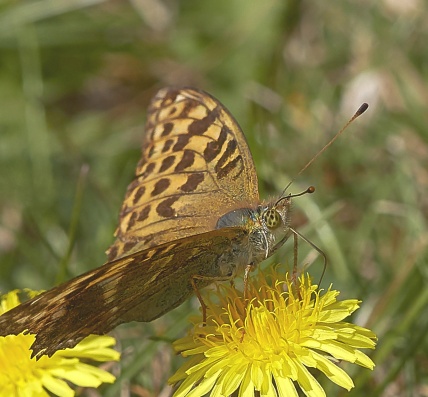
We enjoyed walking
through a lovely peaceful beech wood on our way back.
A number of different fungi were spotted but not
positively identified.
Roesel's
Bush-cricket (male)

On our way back we
went inside St Mary's church to admire the 2 stained
glass windows dedicated to Gilbert White. We enjoyed
trying to identify all the different birds in the 1920
window.
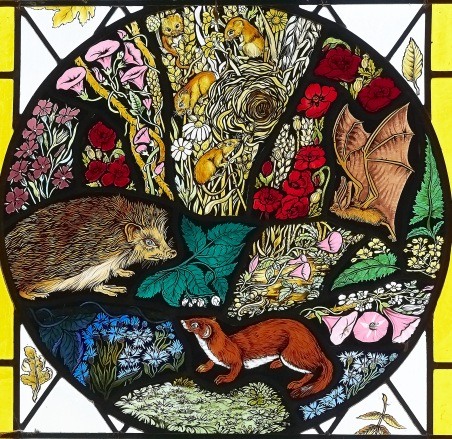
The two young
grandsons with us showed an impressive interest in the
wildlife we saw and were excellent at spotting insects
especially spiders! Thank you all for walking with
me.
SATURDAY
AUGUST 24 - 2019 - Magdelen Down
Tony Wootton
reported on this mornings walk by the Friends of
wildlife Group. 7 of us went to Magdelen Down near
Winchester this morning.
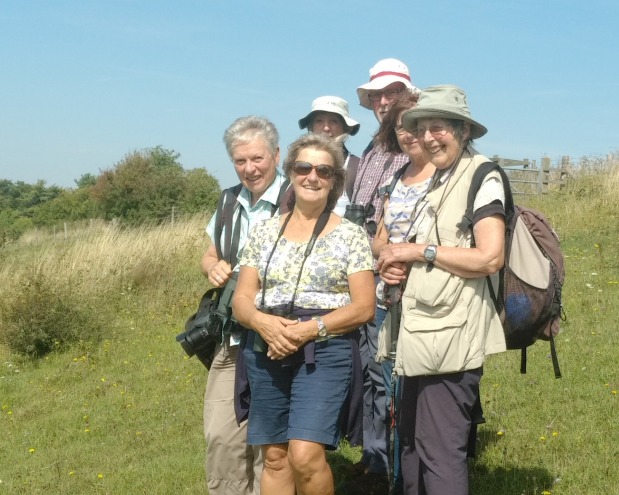
This is one of
Butterfly Conservation's premier sites, mainly never
cultivated chalk down land. It was a beautiful
morning, gentle breeze, virtually a cloudless sky,
temperature nudging 30 degrees. Considering all this I
found it surprising that there was hardly any
visitors, certainly no 'spotters ', and more
worryingly very low numbers of butterflies. Species ok
but actual butterflies not so good.
We saw, red admiral, meadow brown, large white,
common, holly and chalkhill blues, a flash of one
possible adonis, brown argus, painted lady, and
brimstone. Brown Argus and Holly Blue in photo.
Identified insects
were mother shipton , mint moth and one of the robber
flies.
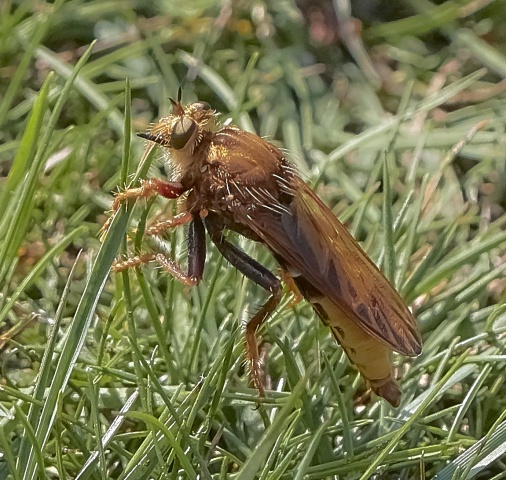
Brian's
note: This is a great shot of a Hornet Robberfly
(Asilus crabroniformis) which is said to
be rare and declining, and scattered in parts of
Southern England. The species is identified by the
yellow tip to its abdomen, usually covered by folded
wings at rest. This magnificent creature is the
largest fly in Britain, hence its common name
'Hornet', though, of course, it does not sting. It
sits and waits for other insects which it catches and
sucks them dry with its proboscis. The 'beard' on the
face protects the eyes from struggling prey.
Birds were, buzzard,
kestrel, herring gull, wood pigeon, green woodpecker
(heard), skylark, swallow, house martin, grey wagtail,
robin, redstart, black bird, blackcap, chiffchaff,
willow warbler, goldcrest, spotted flycatcher,
longtail blue and great tits, carrion crow, raven and
goldfinch.
Thanks as always to
Ros for supplying me with the flower list. Hop
trefoil, wild basil, doves foot cranesbill, dandelion
, daisy, birds foot trefoil, majoram, creeping
thistle, meadow vetchling, woody nightshade, bramble,
white clover, smooth sow thistle, upright hedge
parsley, agrimony, ribwort plantain, herb robert,
prickly sow thistle, creeping buttercup, red
deadnettle, red bartsia, black meddick, wild clematis,
black hoarhound, rosebay willow herb, wild carrot, St.
John's wort, yarrow, creeping thistle, white campion,
field bindweed, mugwort, hedge bedstraw, melliot,
meadow cranesbill, field scabious, common toadflax,
tufted vetch, knapweed broomrape, eyebright, small
scabious, ragwort, hemp agrimony, great willow herb,
wild parsnip, teasel, knotweed, field speedwell,
hawkbit, vervain, welted thistle, bladder campion,
harebell, ladies bedstraw, mouse ear, fairy flax,
clustered bellflower, mignonette, birds eye trefoil,
musk mallow, sainfoin, rock rose, devils bit scabious,
autumn gentian, hogweed, greater knapweed, black
knapweed and scarlet pimpernel. Phew, thanks Ros, and
thanks everyone for coming.
Photo shows . . .
Robin's Pincushion and Clustered Bellflower
But the days highlight
was around 20 yes 20 argiope bruenniche- wasp spiders,
all in one small area.

SATURDAY
AUGUST 17 - 2019 - The Trundle
Nicola Hammond
reported on this morning's walk. Ten met for a walk
around The Trundle this week. Derek taking photo.
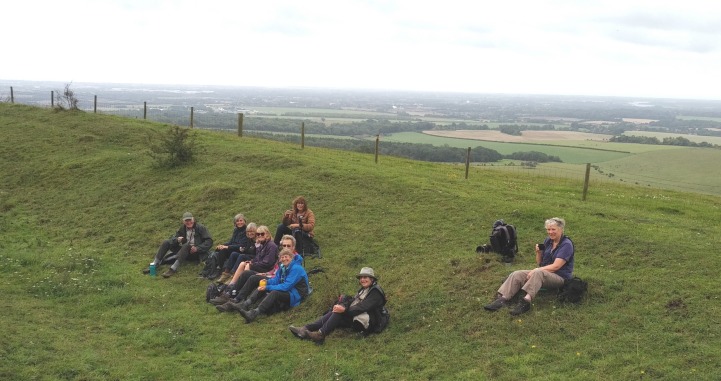
The strong breeze kept
many birds hunkered down out of sight but as we
arrived a kestrel was hovering close by. We were also
treated to views of wheatear and a redstart. A
yellowhammer perched on a fence with food in
its mouth and we watched as it finally flew low down
into a bush, presumably to feed its young.
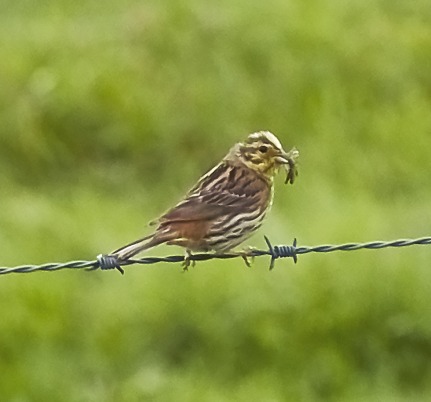
Later on buzzards
soared overhead and corvids enjoyed the thermals.
The short turf had
surprisingly few wildflowers and we presumed this was
due to heavy grazing by cattle (who had left their
mark!). Flowers of note included clustered bellflower,
harebell, dwarf, musk and carline
thistles
Round headed rampion,
small scabious, wild parsnip, toadflax, squinancywort
and eyebright. Wild basil, marjoram and mint
were also seen.
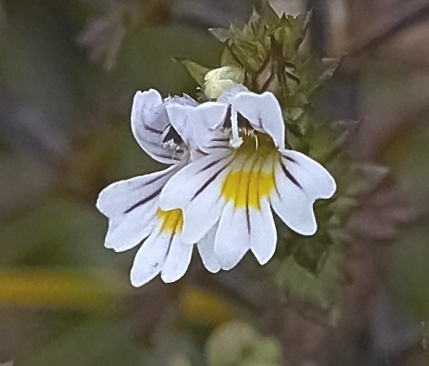
We walked along a
woodland path to the side of The Trundle for some
respite from the wind and were greeted by a party of
long tailed tits. We also saw fungus which we couldn't
identify. In the longer grass along the tracks
surrounding the Trundle we saw meadow brown, large
& small white and painted lady butterflies.
Finally we had wonderful views of chalk hill
blue butterflies and watched as one nectared on a
carline thistle, which showed that it isn't only
colourful flowers that attracted butterflies. It was a
very companionable walk, as always.

SATURDAY
AUGUST 10 - 2019 - St Hubert's Church, Idsworth
Helen Penfold
reported today's walk
Six brave souls had a lovely, somewhat windy but
mostly dry, walk from St Hubert's church this
morning.
Swallows and martins flew overhead as we set off,
walking up the hill to St Hubert's, enjoying the
wildflower meadows, planted by the local farmer. The
wild carrot flowers and all the grasses were beautiful
as they swayed with the wind: other flowers in the
meadow included ox eye daisies, poppies, wild
marjoram, knap weed, May weed, toadflax and St John's
wort.
We walked past the church and through the fields,
seeing a variety of flowers, including pineapple weed,
hogweed, fool's parsley and red pimpernel, clover and
herb robert and passing the old ice house where ivy
leaved toadflax grew in the walls. The woods gave us
some shelter from the winds. Along a very damp grassy
open track within the woods, we saw yellow pimpernel,
common hemp nettle, enchanters' nightshade, ivy leaved
bell flower, figwort, hedge woundwort, meadow
vetchling, corn mint, red bartsia, rosebay willow
herb, agrimony and hemp agrimony among others.
Butterflies included
meadow browns and we watched a beautiful dragon fly
which we think was a Southern hawker.
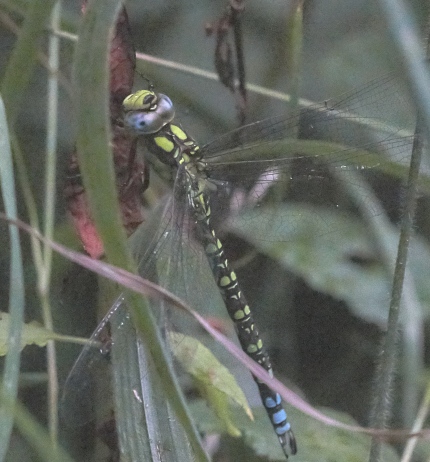
We could hear a young
sparrow hawk calling to its parents and we also heard
long tailed tits, wrens and possibly marsh tits but
didn't see them. Further along, on a gravel track we
saw a clump of small toadflax.

Coming out of the
woods and back onto fields the flowers seems to change
a bit; we saw rest Harrow, black knap weed, tufted and
horseshoe vetch. Beautiful guelder rose berries looked
pretty in the hedge.
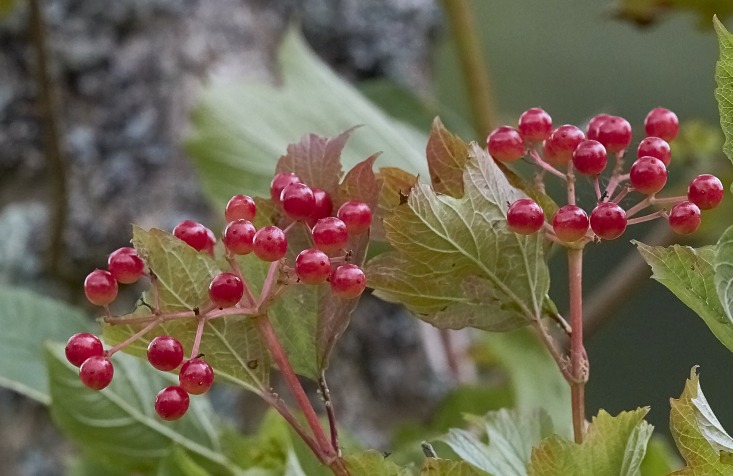
Other flowers seen
included hearts ease, eyebright, field pansy,
fleabane, garlic mustard, and silver weed. Grasses
seen included the delicate wood mellick. We were glad
to get back to the cars without getting too
wet.
Collared
Parachute Fungus

Rosy Footman Moth
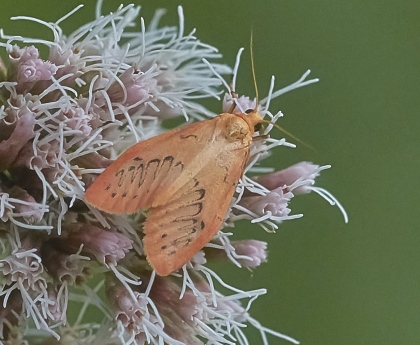
SATURDAY
August 3 2019 - Burton Mill Pond
Tony Wootton
reports on today's walk
Good afternoon everyone, 9 of us had a very pleasant
and warm walk around the pond

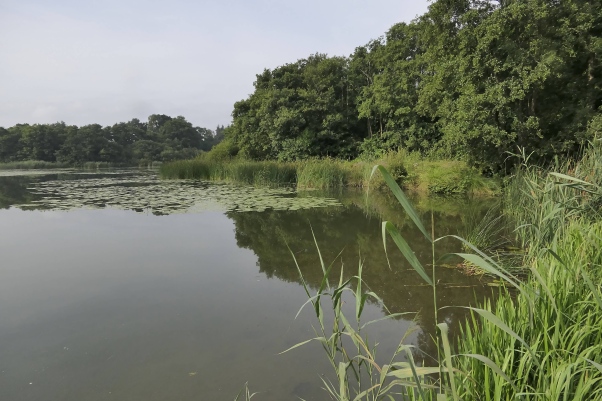
We passed the ancient
sweet chestnuts and through the Black Hole. Very many
thanks to Ros who tells me the most significant
flowering plants we saw were, greater buldock,
watermint, gipsywort, vipers bugloss, angelica,
vervain, knotgrass, fools watercress,brandy bottle
water lily, plus 45 others.
Wild Angelica

Birds seen or heard by
at least one of us included, canada
goose,mallard,tufted duck with ducklings,little
grebe,great crested grebe,cormorant,grey heron,red
kite,sparrowhawk,kestrel,moorhen,coot,stock dove,wood
pigeon,kingfisher,green woodpecker,great spotted
woodpecker,swallow,house martin,wren,robin,song
thrush,reed warbler,blackcap,chiffchaff,willow
warbler,goldcrest,long tail, blue, great and marsh
tits,nuthatch,treecreeper,jay,magpie,jackdaw,carrion
crow,and a chaffinch. The highlights being the
goldcrest and tufted duck families.
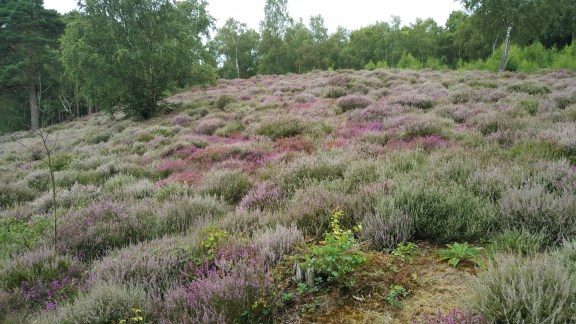
Caroline French is now
sure the juvenile raptors were Sparrowhawks. There are
some recordings of juveniles on this page if anyone
wants to have a listen: https://www.xeno-canto.org/species/Accipiter-nisus
Disappointing insects
though considering the warm weather, only meadow
browns and 3 unidentified dragonflies and 4 blue
damsels.
Heather reports . . .
Some very unusual spiders lurking above the sluice at
Burton Mill. Not identified. A large hoverfly
Volucella Pellucens and I think Water
Plantain.
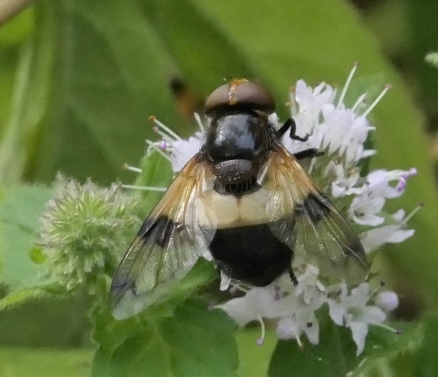
SATURDAY
JULY 27 - 2019 - Langstone and Southmoor
Neill Foster
reported on this morning's walk
An enthusiastic group of eleven met at The Ship with
an anticipation of enjoying the first morning of cool
light drizzle after the prolonged spell of hot, dry
weather!
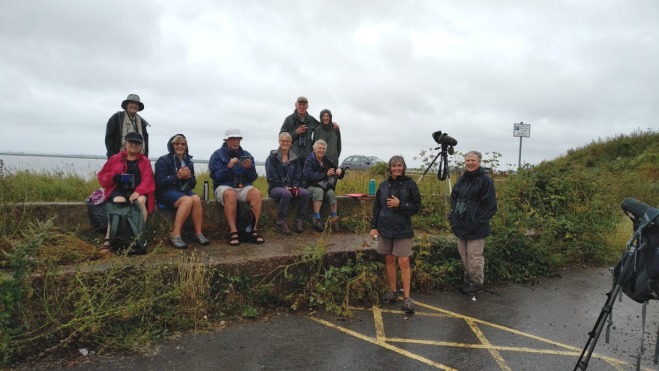
Another attraction, of
course, was the chance at Langstone Millpond of
witnessing the first breeding cattle egrets recorded
for Hampshire and we spent some time observing the
nests from the sea wall path. Obliging adult birds
were showing well and some young could be seen
occasionally in the nests. Grey herons and little
egrets stood in attendance.
Around the millpond were coots, moorhens, mute swans,
cormorant, magpie, collared dove, numerous mallards,
and a robin, while a wren bobbed around feeding. The
tide had begun to ebb and around the harbour, amongst
the many black-headed gulls, we found a sizeable flock
of redshank and a dunlin showing a dark
underbelly.
In flower along the sea wall path were sea lavender,
hemp agrimony, gypsywort, golden samphire, common
mallow, water figwort, and perennial
sowthistle.
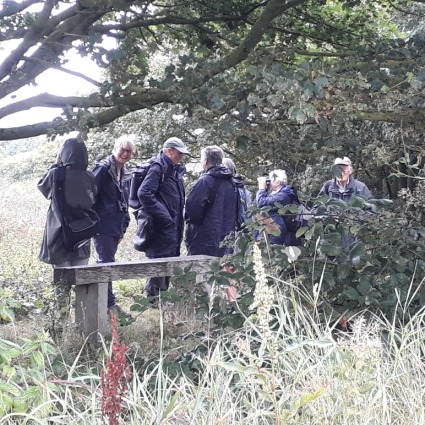
We then set off on our
walk, which would take us along the lane to Langstone
West Mill for a clockwise circuit around Southmoor.
Just past the mill we were delighted to see a
kingfisher flying down the river. Flowering here were
creeping thistle, yarrow, ragwort and drifts of great
willowherb. In the drizzle we did not expect to find
any butterflies but as we disturbed the long grass
bordering the path we flushed a meadow brown and holly
blue.
From the sea wall path, as well as the numerous
black-headed gulls and oystercatchers, we found a
couple of bright turnstones, black-tailed godwits,
curlews, a pair of mute swans with cygnets, a
whimbrel, and a great crested grebe. A green
woodpecker was perched on one of the fence posts.
On the shingle, what appeared to be a burnet rose had
striking deep pink flowers. Sea campion spread around
close by. Two large tamarisk shrubs were flowering
well. Flying around over the moor, as the rain
cleared, were skylarks, meadow pipits, a kestrel,
goldfinches and many flocks of starlings. Whilst
having coffee on the sea wall we examined yellow and
black caterpillars of the cinnabar moth on
ragwort.
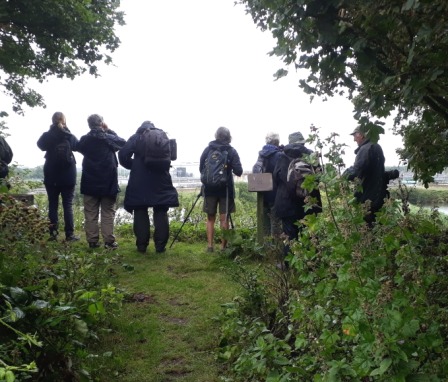
Other birds, found
around the treatment works, included tufted duck with
young, gadwalls, swallows, little grebes, and several
whitethroats. In flower here were chicory, bristly
lettuce, bristly oxtongue, lesser burdock, spear
thistle, wild teasel, common and musk mallows.
We returned via the moor path and found woody
nightshade, tufted vetch, common fleabane, perforate
St John's-wort, agrimony, water mint, stone parsley
and one other butterfly - a gatekeeper. Finally, a
sparrowhawk glided over.
Thanks to Sue and Derek for the photos and to Ros for
many flower identifications.
SATURDAY
JULY 20 - 2019 - Warsash
Fay Durant
reported on this morning's walk
Surprisingly , six people turned up for the walk today
, considering the heavy rain during the night . We
parked in the car park by the river and walked along
the path , as far as the crossing to Hollyhill
Woodland Park , which is only accessible at low tide
.
We crossed and made our way , through the woods , to
the lakes at the top . We returned , via the road ,to
the river path . There were a number of black tailed
godwits in the river , some in their lovely summer
plumage . The usual red shank , oystercatchers , a few
curlew and a green shank with unusual markings , which
again could have been in summer plumage or a youngster
.
Very little bird song in the woods , a jay was heard
and some members of the tit family . I was just
commenting on the grey wagtail we used to see in the
stream when a bird flew into a tree and started
calling - it was a grey wagtail and perched for us all
to see - wonderful sight .
The ponds had the usual mixture of mallards and
possibly farm ducks .Returning along the river path
Tony noted a little egret and a heron , plus redshank
, green shank and a whimbrel . Neill pointed out a
sandwich turn flying and diving into the river .
A good list of flowers identified by Ros : rock
samphire , wild carrot , hogweed , yarrow , cow
parsley , bristly ox- tongue , cat's ear , nipplewort
, perennial , smooth and prickly sow thistle , tree
mallow , common mallow , mayweed , enchanters
nightshade , woody nightshade , sea lavender , sea
aster , ribwort plantain , field bindweed , pendulous
sedge ++ , yellow loosestrife , purple toadflax ,
spear thistle , creeping thistle - a large splash of
blue in a field , greater willowherb , fleabane , and
woodavens .
Very few butterflies : holly blue , Meadow brown ,
several gatekeepers and a small white .
A very pleasant way to spend a morning .Best wishes ,
Fay
SATURDAY
JULY 13 - 2019 - Portsdown Hill
Ros Norton
reported on this morning's walk
Today a select group of 4 met near Fort Widley on a
lovely sunny morning and walked west on north side of
fort , then crossed road and continued to roundabout
on upper path , returning on a slightly lower
path.
We saw or heard a few birds including swifts,
swallows, whitethroat, greenfinch, blackcap,
yellowhammer, goldfinch, rooks, crows and
jackdaws.
There were many butterflies including gatekeepers,
meadow browns, marbles whites, skippers, large whites,
a red admiral, peacock and common blue.
Other insects included bumble bees, a thigh beetle,
soldier beetles and ladybirds.
Flowers were at their peak with a wonderful display of
colours. Knapweed broomrape was going over , pyramidal
orchids were still flowering and wild parsnip and hemp
agrimony were beginning to flower.
Among the other flowers seen were rosebay and great
willowherbs, nettle leaved bellflower, rest harrow,
meadow vetchling, Lucerne, tufted vetch, kidney vetch,
melilot, hogweed, wild carrot, squinancywort, lesser
centaury, yellowwort, red bartsia, eyebright, self
heal, yellow rattle, bristly and hawkweed ox-tongues,
perennial sow thistle, ragwort, wild marjoram and
basil, thyme, ladies and hedge bedstraw, field and
small scabious, musk mallow, vervain, creeping, spear
and musk thistles, black and greater knapweed and
vipers bugloss.
SATURDAY
JUNE 29 - 2019 - Noar Hill
Report by
Nicola Hammond
We were lucky to have the expertise of Nigel and
Rosemary for this week's walk at Noar Hill. It was
very much "eyes down" as the display of wild flowers
was magical. However we were greeted by singing
yellowhammers when we arrived and one obligingly posed
on the telegraph wire for us.
As we entered the reserve the paths were soon lined
with both pyramidal and common spotted orchids.

Nigel and Rosey showed
us a rare example of pyramidal orchid (named
pyramidal orchid var. emarginata) which has an
almost unlobed lip. Later on Rosey also showed us a
white variant of pyramidal orchid (var.
albiflora).
Chalk fragrant
orchid lived up to its name and we were also on
our knees to view the diminutive musk orchid. Common
twayblade was abundant and a frog orchid in seed was
also seen.
We were fascinated to
see an impressive funnel shaped spider's web with its
owner in residence (which I believe is a Labyrinth
spider).

Nigel pointed out to
us some vehicle tracks and the fairy shrimp lives in
puddles on these tracks. Their eggs survive dry
periods in between rainy spells. Rosey also took us to
see a rare plant - Dragon's teeth - a member of the
pea family which is only present here and a couple of
other sites in the UK.
Among all the glorious
wildflowers we saw were milkwort, fairy flax, small
scabious, common juniper, birds foot trefoil, kidney
vetch, perforate St John's wort, spear thistle, marsh
thistle, agrimony, hemp agrimony, wall lettuce, black
medick, restharrow, hedge woundwort, wild marjoram, ox
eye daisy, yellow rattle, self heal, yellow wort,
hoary plaintain, hedge & ladies bedstraw, greater
knapweed, common broomrape and knapweed broomrape,
Butterflies we could
positively ID were marbled white, meadow brown and
small blue. We walked around the reserve to song from
yellowhammers, song thrush, blackcap and whitethroats
.Finally, as we left,the heady scent from elder
flowers washed over us.
FOR
EARLIER REPORTS GO TO . . 2019
Jan-Jun